Samsung Q70D performed in the test exactly as it should for its price range – very competently. The strongest aspects of the television are certainly its performance when using a console and colour reproduction after the calibration process. The former will undoubtedly catch the attention of gamers with a range of conveniences that Samsung Q70D can offer, and there are quite a few, including that which is almost exclusive to the manufacturer's units – the ability to smooth out gameplay while still maintaining reasonable input lag, allowing titles running at 30 fps to perform like those at native 60 frames per second. In the context of gaming, one cannot forget the well-implemented HGIG mode, which, when set correctly, is on par with games using Dolby Vision. We must also acknowledge the easy pairing of the television with the Canal+ decoder, which is not such an obvious advantage, but we know that many people experience issues with this. Staying on the topic of television, it must be noted that the Samsung Q70D offers very good brightness in SDR content for its price range, making daytime viewing more than comfortable. A downside for the tested television is the lack of Dolby Vision, which would have significantly enhanced performance at the maximum brightness of the Samsung Q70D. The device's construction flaws should not be overlooked, as they may (though not necessarily) lead to light bleed that can be noticed in dark situations during dimly lit scenes. What cannot be taken away from the Samsung Q70D is the fact that it features one of the better motion smoothers in its price bracket, which works excellently for sports events or fast-paced action scenes. The system responsible for the television's operation runs very smoothly, and the only thing we can criticise it for is the absence of the Tidal app. In summary, the Samsung Q70D represents a good continuation of the manufacturer's seventh series, which year after year is gaining – firstly, in quality, and secondly, in popularity.
- Matching (Score)
- Our verdict
- TV appearance
- Where to buy
- Contrast and black detail
- HDR effect quality
- Factory color reproduction
- Color reproduction after calibration
- Smoothness of tonal transitions
- Image scaling and smoothness of tonal transitions
- Blur and motion smoothness
- Console compatibility and gaming features
- Input lag
- Compatibility with PC
- Viewing angles
- Daytime performance
- Panel details
- TV features
- Apps
- Playing files from USB
- Sound
Samsung QLED Q70D / Q74D / Q77D vs Haier Q80FUX
Direct comparison
Q70D / Q74D / Q77D


Panel type: LCD VA
Resolution: 3840x2160
System: Tizen
Model year: 2024
Complete the survey to find out the result

Panel type: LCD VA
Resolution: 3840x2160
System: Google TV
Model year: 2025
Complete the survey to find out the result

Overall rating
6.8
5.8
Movies and series in UHD quality
6.1
5.9
Classic TV, YouTube
6.0
5.6
Sports broadcasts (TV and apps)
6.5
4.7
Gaming on console
8.7
6.7
TV as a computer monitor
8.0
6.0
Watching in bright light
5.4
4.8
Utility functions
7.4
5.6
Apps
8.7
9.6
Sound quality
6.3
5.5
Complete the survey to find out what fits your preferences
Advantages
Excellent performance with consoles and computers
Colour reproduction after the calibration process
Very good performance in sports - advanced motion smoothing system
Smooth and trouble-free operation of the Tizen system
Very good tonal transition quality within this budget
Very good native contrast and decent black (thanks to the VA panel)
PFS / QLED Filter - Wide colour gamut (about 95% DCI-P3)
Remarkably low input lag (below 10 ms at 120Hz and about 12 ms at 60Hz), making it a great choice for fast-paced games.
Support for 120Hz at lower resolution (Full HD) and the presence of VRR and ALLM
Support for Dolby Vision
Well-functioning file player via USB
Presence of analogue headphone output (jack)
Disadvantages
Possible noticeable light leaks
No Dolby Vision support
The image is quite "blown out" in HDR
Google TV software is full of bugs, poor translations, and issues
Lacks any image enhancement features (noise reduction, gradient smoothing)
Average brightness
Flat, bass-less sound
High input lag in Dolby Vision mode for gaming
Weird and not very ergonomic remote
Our verdict
The Haier Q80FUX television is one of the most schizophrenic propositions we have had in our editorial office for a long time. On one hand, we have a solid piece of equipment: a VA panel guaranteeing deep blacks, as expected for this segment, and a QLED quantum filter that can indeed generate juicy, eye-catching colours. This is the foundation on which a truly competitive mid-range receiver could have been built. Unfortunately, all this potential of the matrix is systematically undermined by the software, which is a real anchor for this model. The biggest Achilles' heel of the Q80FUX is its total capitulation in dealing with HDR10 materials. The electronics seem to completely misunderstand how to interpret the signal, resulting in it consistently blowing out the brightest parts of the image, turning them into a flat, milky spot. Adding to this is the Google TV system, which – while functional – is unstable, full of bugs and annoying oversights, giving us an image of a raw product that clearly reveals the producer's lack of experience. Just when we were about to write this model off, we discovered its surprising niche. After connecting a console, the Q80FUX undergoes a transformation. It turns out that this television offers remarkably low input lag, fully supports VRR, and can handle a 120Hz signal in Full HD resolution. In the gaming world, where responsiveness is everything, these parameters put it in a very good light. So we are dealing with a device of very narrow specialization. It is not a universal living room television – it lacks stability and, above all, any correctness in handling films. It is rather a budget, large-format monitor for gamers, who can consciously forgive it all the software flaws in exchange for those few key attributes for console/PC at a relatively affordable price.
TV appearance




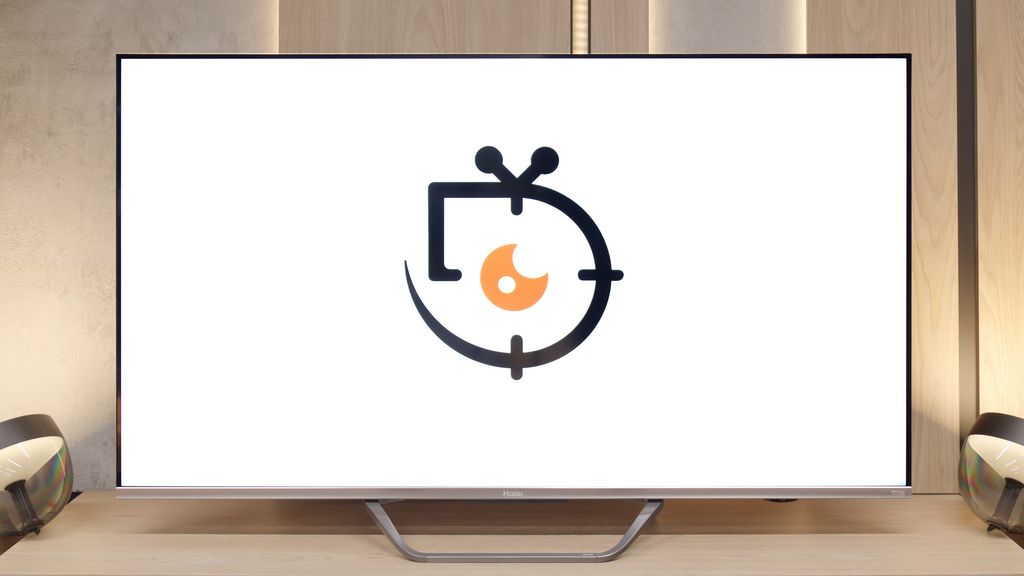
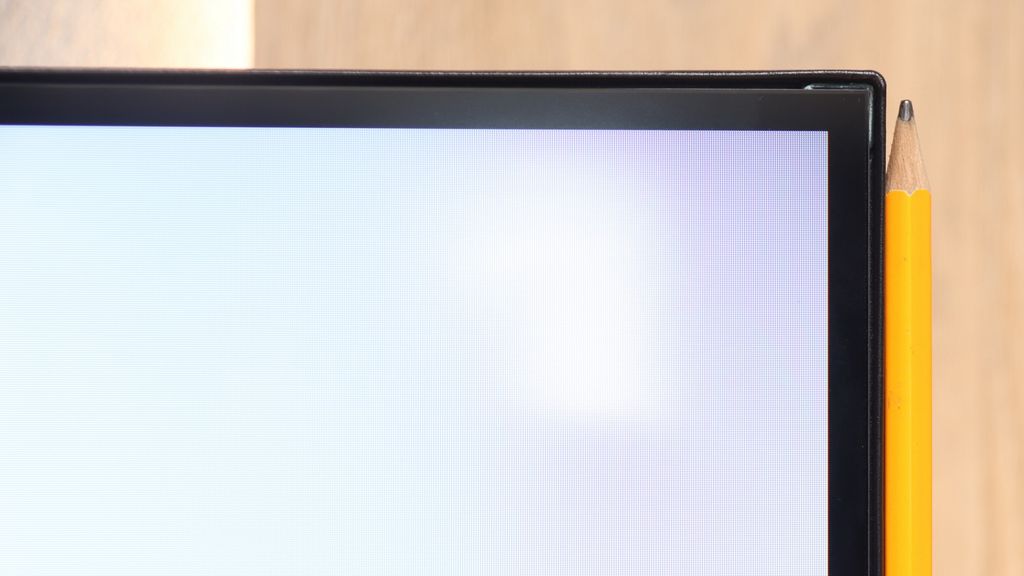
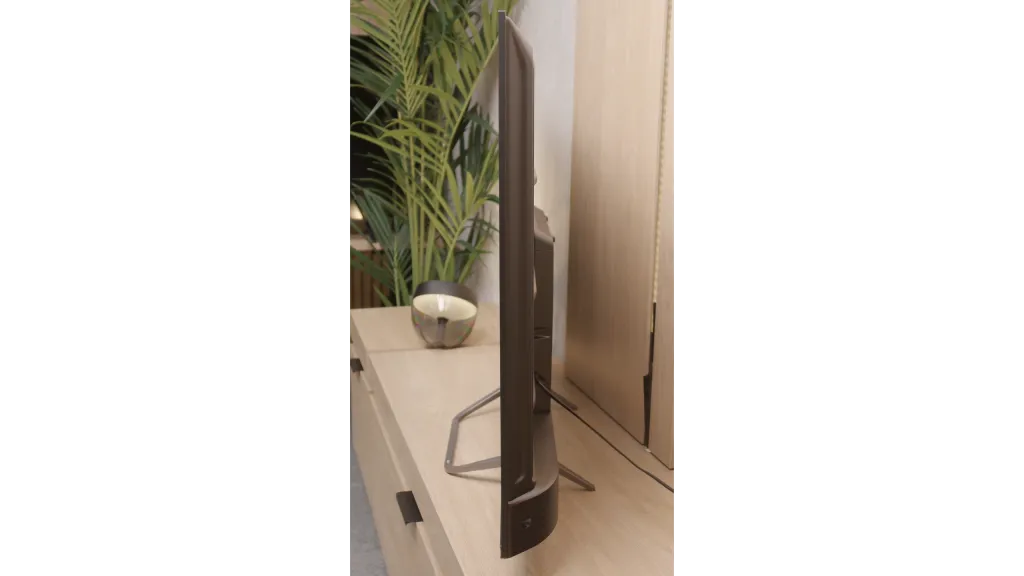
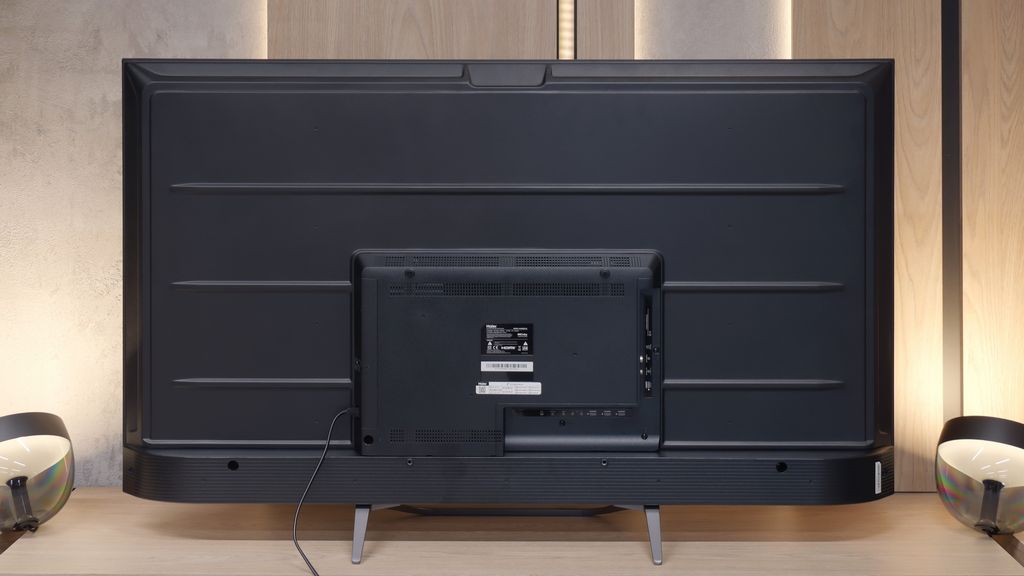
Contrast and black detail
5.4/10
6.3/10
Local dimming function: No
Local dimming function: No
Contrast:

Result
2,450:1

Result
5,150:1

Result
6,550:1

Result
5,850:1

Result
2,800:1

Result
5,200:1

Result
7,400:1

Result
7,550:1

Result
7,300:1

Result
6,450:1
Halo effect and black detail visibility:

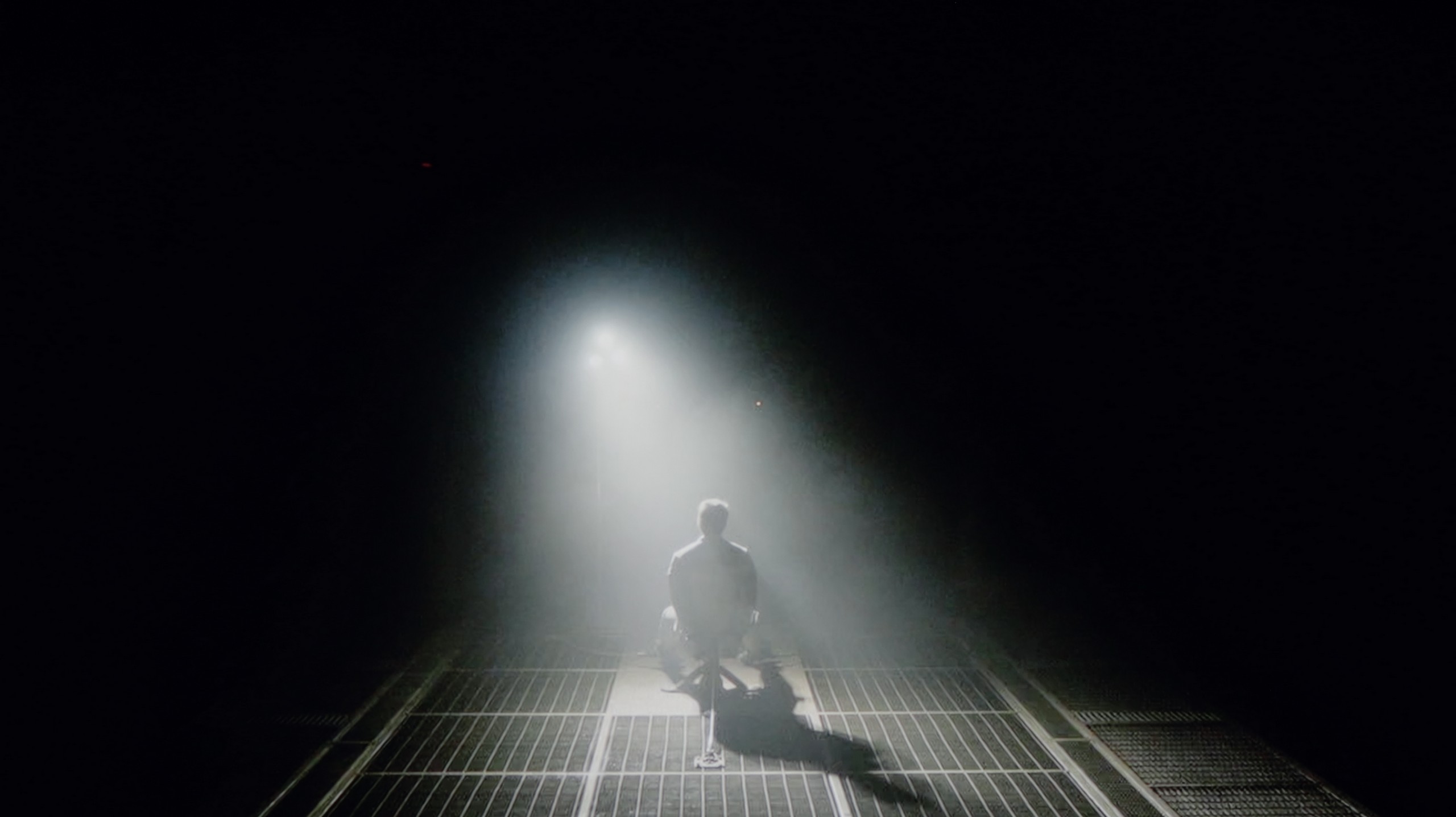
Samsung Q70D and its related models, such as Q77D and Q74D, use a VA panel, which should inherently provide decent contrast. Typically, it is several times higher than that of IPS/ADS screens that do not come equipped with an advanced local dimming system. As you can see, contrast results are quite varied, which is caused by the unevenness of the panel. Therefore, we might sometimes get good contrast, and other times it can be significantly worsened, but generally, it remains fairly consistent, aside from light bleed. Let’s take a look at the film scenes we prepared from "Oblivion" and "Revenant." As we can see, in the first one, the lights are well separated, which is a positive phenomenon, as the visibility of details in bright areas in further tests should be equally good. What stands out the most here is the unusual oversharpening of the smoke visible under the light and the navy black in the background. In the frame from the second film, the first thing that stands out is the unevenness of the backlighting of our piece. This was significant and strongly affected the perceived image. Nonetheless, the details in the film were well visible.
I must admit that approaching a TV in this price range, one instinctively crosses their fingers, hoping that at least the black won't be a grey blotch. Meanwhile, the Haier Q80FUX, specifically the 55-inch unit we have in our office, can pleasantly surprise in this regard. Its secret lies in the use of a VA panel, which tends to generate high contrast by nature. And these are not empty promises. During screenings, in the majority of film scenes, the contrast reported itself at levels ranging from 5000:1 with commendable regularity, often reaching as high as 8000:1. These are really strong results, considering the fact that this TV has no, not even minimal, form of local dimming. Translating this into couch-side experiences: for its price point, the Q80FUX offers solid black levels. Of course, it isn’t that perfectly velvety depth that makes the screen disappear into darkness. When we conduct a viewing in total light isolation, we can see that in the darkest parts of the image, the black betrays its budget origins, subtly shifting towards a bluish glow. However, this is a defect that is easy to mask – just a bit of light from a lamp in the corner of the room is enough for this nuance to become invisible, and the image regains a satisfying depth.
HDR effect quality
5.5/10
4.9/10
Luminance measurements in HDR:

Result
433 nit

Result
461 nit

Result
477 nit

Result
475 nit

Result
490 nit

Result
308 nit

Result
327 nit

Result
352 nit

Result
330 nit

Result
344 nit
Scene from the movie “Pan” (about 2800 nits)


Scene from the movie “Billy Lynn” (about 1100 nits)


Static HDR10


Dynamic: HDR10+
Dynamic: Dolby Vision


HDR luminance chart:
Haier Q80FUX
HDR luminance
Samsung QLED Q70D / Q74D / Q77D
HDR luminance
Luminance of RGB colors
The brightness that the Samsung Q70D can offer is at a rather average level, although it cannot be said that the HDR effect will not be noticeable. Any brightness above 400 nits allows for a clear distinction between SDR and HDR content. As was the case in the paragraph about contrast and black levels, we can also observe here that the first scene, featuring a bright sunny sky and a darker foreground, has the lowest luminance of those measured. The result, which can be considered very good for this price range and display class, is that one. In a scene where we see a large light source filling a significant portion of the frame, the brightness of the TV is at its highest, reaching nearly 500 nits. However, it is worth noting the rather low coverage of the wide DCI-P3 colour gamut, which sometimes results in noticeable shortcomings in the colour reproduction. Additionally, users can enjoy rich colours and high precision in rendering shades, making movie screenings a unique experience. It is also worth mentioning that the Q70D Samsung panel performs excellently in eliminating blur during dynamic action scenes, which enhances the viewing comfort of sports broadcasts or games.
Alright, let's move on to the topic that really sparks discussions, which is the capabilities of the TV in HDR mode. Let's be clear from the start: the Haier Q80FUX is certainly not a brightness demon. The panel of this set can generate about 350 nits at peak, which in today's reality is an absolute minimum to even talk about the presence of HDR expanded dynamic range. On the plus side, this brightness is at least stable – regardless of the test pattern or film scene we used, measurements consistently hovered around 300-350 nits. These are at best adequate results, definitely far from the dazzling display of capabilities that we know from more expensive models. Fortunately, there is one aspect where the Q80FUX makes up for these shortcomings and does so considerably. We are talking about a QLED TV (or more precisely PFS LED), which means that thanks to the quantum dot filter used on the panel, it can generate truly juicy, vibrant colours. These are not empty promises – covering nearly 95% of the DCI-P3 colour gamut is an impressive result and directly translates into very pleasant, saturated colours for the eye.
Factory color reproduction
6.1/10
4/10


Factory Mode
After calibration
The best factory mode in Samsung Q70D is "Filmmaker," and it was this mode that we used during all our tests. Before the calibration process, it had several flaws that effectively hindered the presentation of the director's intentions. In both SDR and HDR material, the white balance was dominated by red and green colours. As a result, there was a characteristic yellow tint on the image, which caused whites to appear yellowed and skin tones to be noticeably too warm. The reduced gamma in standard colour palette materials caused a significant drop in contrast, which was already not the highest. This led to the highlighting of details in the blacks, but also to clipping in brighter scenes. In this case, the EOTF curve proved to be much better and only brightened those scenes with quite low luminance. This was clearly visible in the section where we measured the maximum brightness of the television in HDR materials. At that time, a shot from the film "Billy Lynn" appeared unnaturally bright and lacking depth.
Factory settings for movie mode are seldom perfect, but in the case of the Q80FUX, we encountered a noticeable imbalance. In SDR content, the image was definitely too warm, due to an excessive amount of red in the white balance, giving the overall picture a slight sepia tone. Conversely, in HDR materials, the television fell into the other extreme – an excess of blue caused an unnatural, cool effect in perception. However, it wasn't the fickle white balance that was the biggest issue with this TV. The real culprit, responsible for the previously described problems, was hiding deeper. It turned out that the Q80FUX has completely miscalibrated gamma values and, crucial for HDR, a poorly executed EOTF curve. It was these erroneous factory settings that caused the notorious clipping of the brightest parts of the image, imposing that characteristic milky filter over them. Thus, we found the source of the problem. This situation led to general, significant colour inaccuracies that were easy to catch even for an untrained eye. Like every television we tested, we decided to calibrate this model as well, and you can find the results of these adjustments in the next paragraph.
Color reproduction after calibration
8.1/10
6.1/10




Fortunately, Samsung provides a wide range of calibration tools in all its TVs, including 2- and 20-point grey scale adjustments and advanced CMS. As a result, we were able to significantly improve the quality of SDR and HDR content. The vast majority of errors have been corrected, and the image that the Samsung Q70D now delivers is definitely much closer to the reference. Higher deltaE errors in wide dynamic range content primarily result from the display's insufficient luminance.
The results of our calibration procedures must, unfortunately, be regarded as twofold. Generally speaking, the picture is undeniably better than before the adjustments; however, the biggest winner of this process has been SDR content. It is precisely here, after correcting the gamma curves and white balance, that we achieved results that can safely be called very good. Once set up, the Q80FUX truly shines in standard dynamic range, displaying only slight errors in the most challenging skin tones. Unfortunately, the weakest link remains HDR content. And here's the paradox: even though we managed to calibrate the white balance to near perfection, the overall colour errors still remain at quite a high level. The reason is that the television still interprets the static HDR10 metadata "in its own way," stubbornly enforcing that unfortunate image clipping effect, which inevitably leads to significant distortions. Although we successfully eliminated the factory excess of blue, due to this electronic interference, the screen can still veer into somewhat too cool tones. That’s just how this television is.
Smoothness of tonal transitions
6.9/10
7.5/10












Considering how important lighting is in films and series, the overlapping structures and fluidity of tonal transitions constitute an extremely significant element in assessing image quality. The colour grading on the tested television is at quite a decent level. It cannot be said that it is outstanding, but it is not bad either. We assess it as acceptable. Brighter scenes perform best here, demonstrating the least amount of choppiness. In scenes recorded in darker settings, slight shortcomings in grading can already be noticeable, although it is not an issue that would cause discomfort while watching. This may be disturbed by the leaking backlight, which is clearly visible in the last image.
Analysing the ability of the television to handle subtle tonal transitions, or "banding", leads us to some interesting conclusions. The Haier Q80FUX seamlessly blends adjacent colours in most scenes, creating a smooth, cohesive image. However, this process is not without its flaws. During our tests, we noticed minor issues and imperfections in each of the test scenes we used. These may not be errors that aggressively jump out and ruin the viewing experience, yet their presence is worth noting. Interestingly, this receiver does not exhibit any particular weaknesses or strengths in this regard – it handles this challenge in exactly the same way, regardless of whether it is displaying delicate gradients of a bright sky or dark transitions in shadows.
Image scaling and smoothness of tonal transitions
7/10
4/10
Smooth transition function

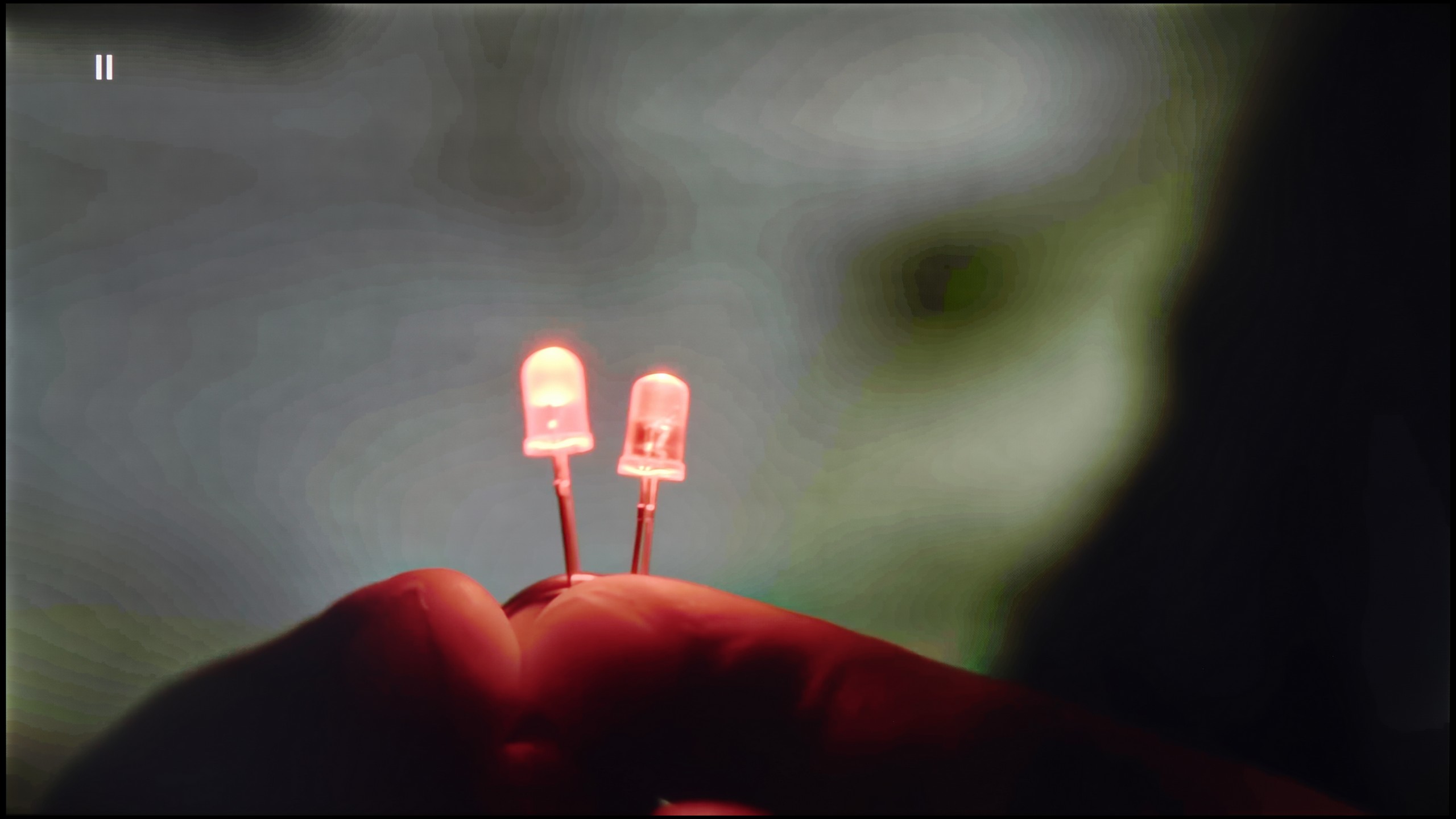
Image without overscan on the SD signal


The function responsible for improving gradation is named "Noise Reduction" in the menu. As we have confirmed, it is worth enabling as it has a beneficial impact on tonal transitions. More importantly, it does not negatively affect film grain or fine details, which sometimes the competition "offers" us.
The image scaling on Samsung Q70D should be rated as average. The manufacturer does not aim to artificially sharpen the image, but rather to keep it naturally softened.
If there's one area where Haier clearly shows it still has a lot to catch up on compared to the market leaders, it's digital image processing. The upscaling, well... it's just okay. And that's really all that can be said about it. It does what it's supposed to do: ensures that lower resolution signals don't scare you with harsh pixelation on the screen and don't look like a forcibly enlarged postage stamp. However, it's far from the finesse and "intelligent" sharpening that more experienced players in this market have developed over the years. The biggest issue with the Q80FUX software is the almost complete lack of additional "cleaning" and smoothing features for the image. The receiver offers no noise reduction mechanisms or gradient enhancement. This means that with older or highly compressed materials, we simply have to accept that all the imperfections in tonal transitions or colour blending, which we mentioned earlier, will constantly accompany us during viewing.
Blur and motion smoothness
7.4/10
4.5/10

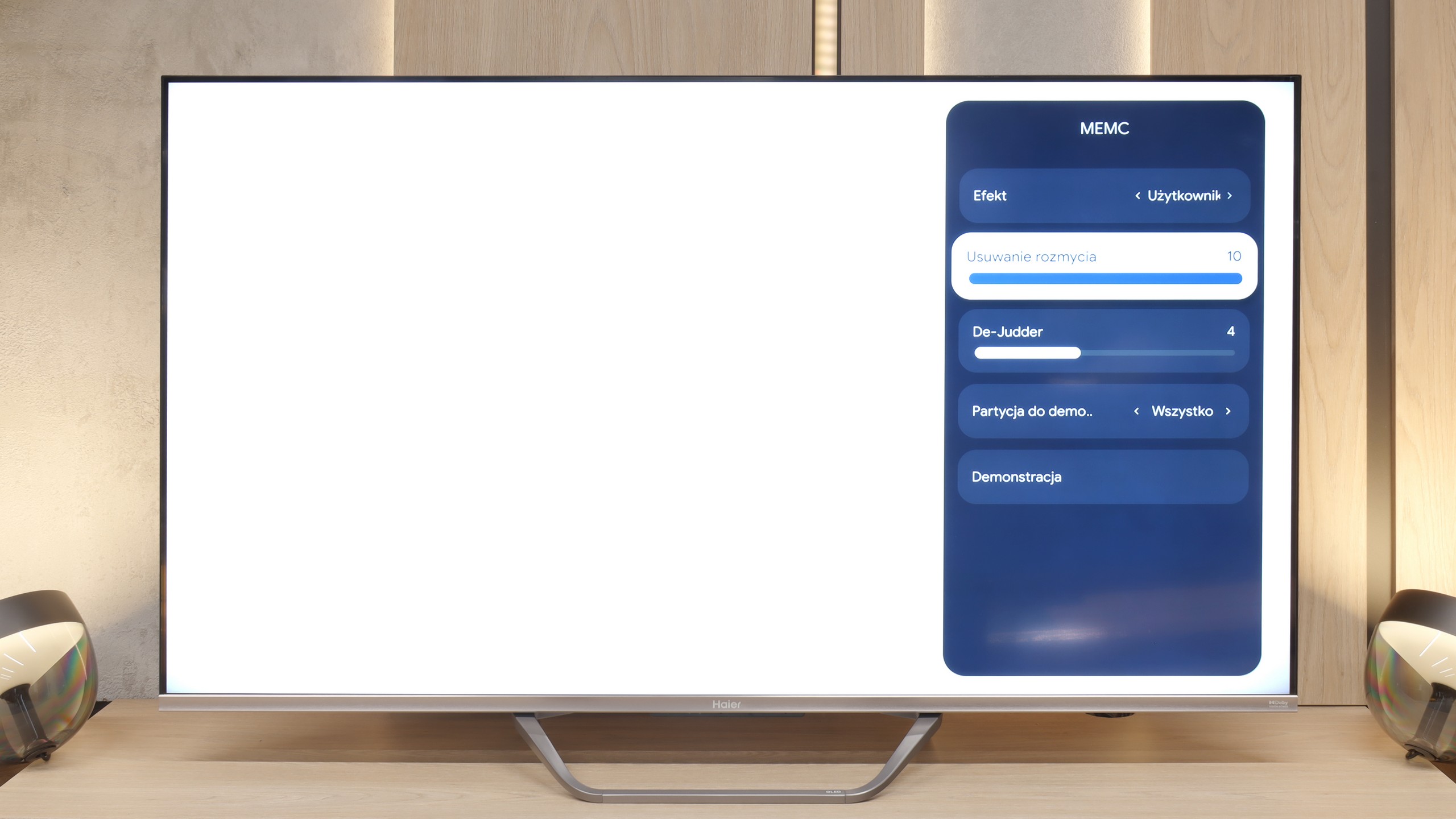
Blur (native resolution, maximum refresh rate):



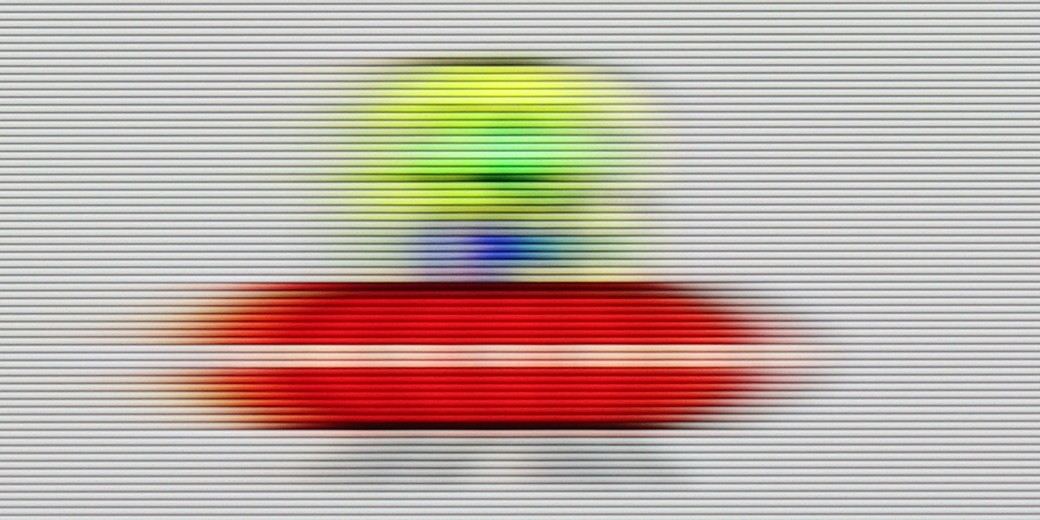
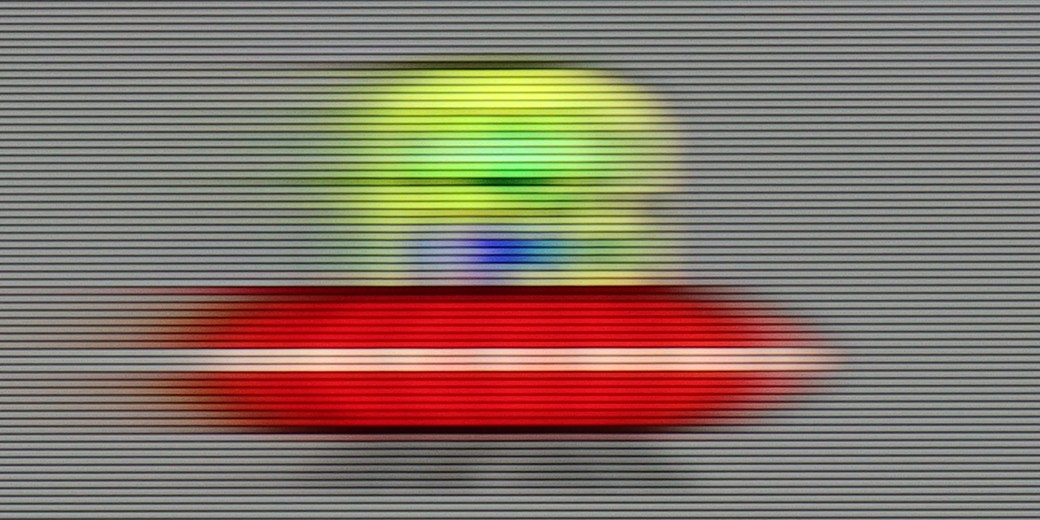
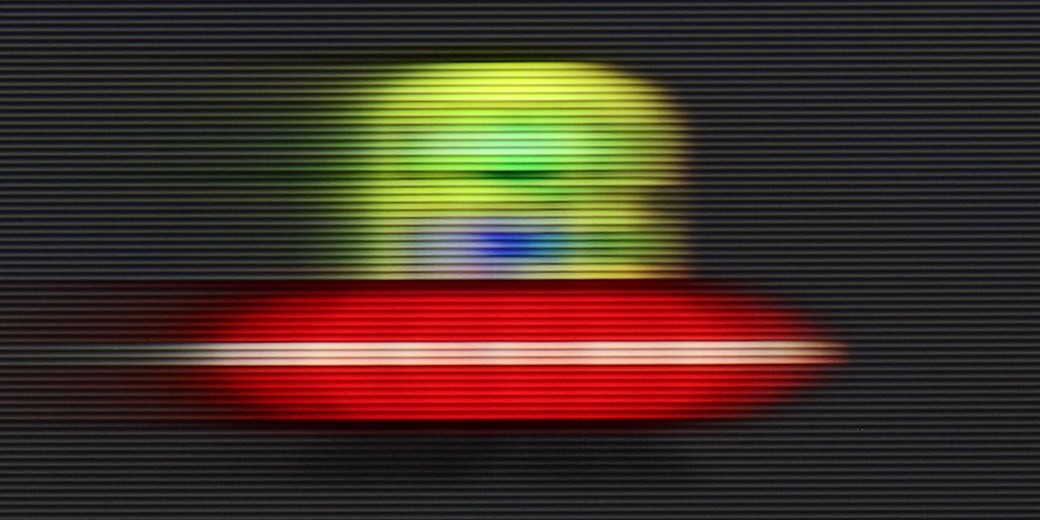
Blur (BFI function enabled):
Image flickers in this mode



Samsung Q70D is the first model in the manufacturer's portfolio with a 120Hz panel. As a result, its motion smoothing features are more advanced than those in lower-tier models. In the menu, we find three functions responsible for improving fluidity. They are "Blur Reduction," "Judder Reduction," and "Clear Motion (LED)." We'll discuss the third one later. The first function enhances sharpness in motion, while the second adjusts the level of smoothing. The smoothness enhancer in Samsung Q70D works satisfactorily, and each setting makes a noticeable difference. Therefore, those who dislike the characteristic stuttering of films or who passionately watch sports will be able to achieve their preferred level of smoothness. In the image, we present a setting with slight smoothing, without the soap opera effect.
The panel used in Samsung Q70D has a fairly good response time for this type of display. Of course, it won't deliver an image as sharp as a proverbial razor, but at this price point, it is a recommended choice for all kinds of sports.
The issue of motion fluidity and blurring is largely predetermined by the use of a 60Hz panel, which naturally makes it difficult to recommend this receiver to enthusiasts of very dynamic content. Fortunately, in the Q80FUX, we find a few options (although, as will soon become clear, really just one) intended to enhance the experience with older film productions. There is a "De-Judder" slider available, which indeed affects motion fluidity and allows us to adjust it to our preferences: from raw, cinematic frame rates to a more theatrical, smoothed presentation. However, a true surprise awaits us right next to it in the menu. There is also a second slider, supposedly dedicated to removing blur – this is a feature we typically encounter in 120Hz panels, aimed at combating blurring in sports. As we expected, recalling memories from testing the K85F model, here too this slider is merely a façade. Its adjustment contributes absolutely nothing to the picture and simply seems to be an oversight by the product engineers who left a non-functional option in the software for this type of panel.
Console compatibility and gaming features
9.5/10
5.6/10
- ALLM
- VRR
- VRR range48 - 120Hz48 - 120Hz
- Dolby Vision Game Mode
Yes, high input lag
- Correct implementation of HGIG
- 1080p@120Hz
- 1440p@120Hz
- 4K@120Hz
- Game bar

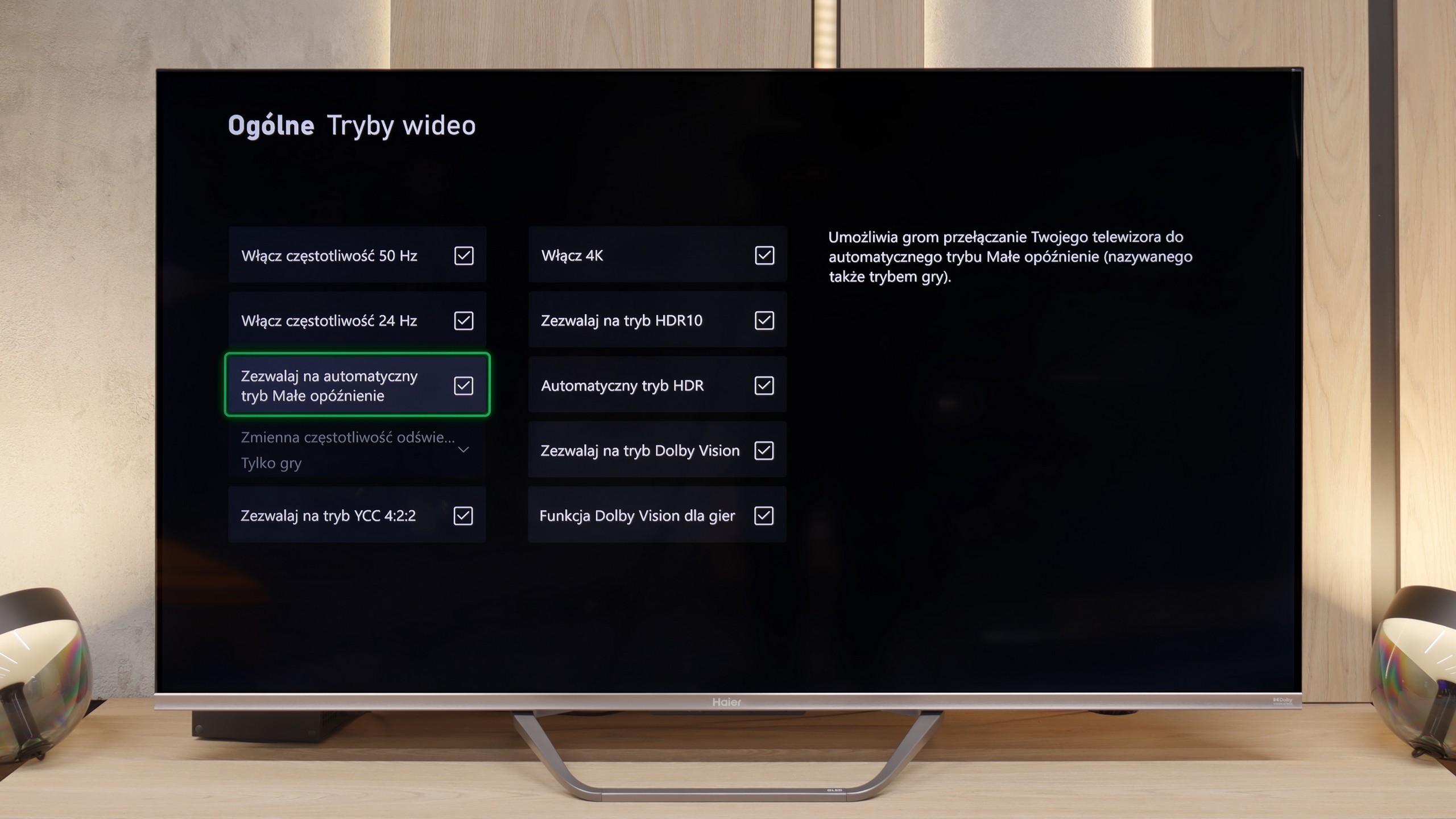

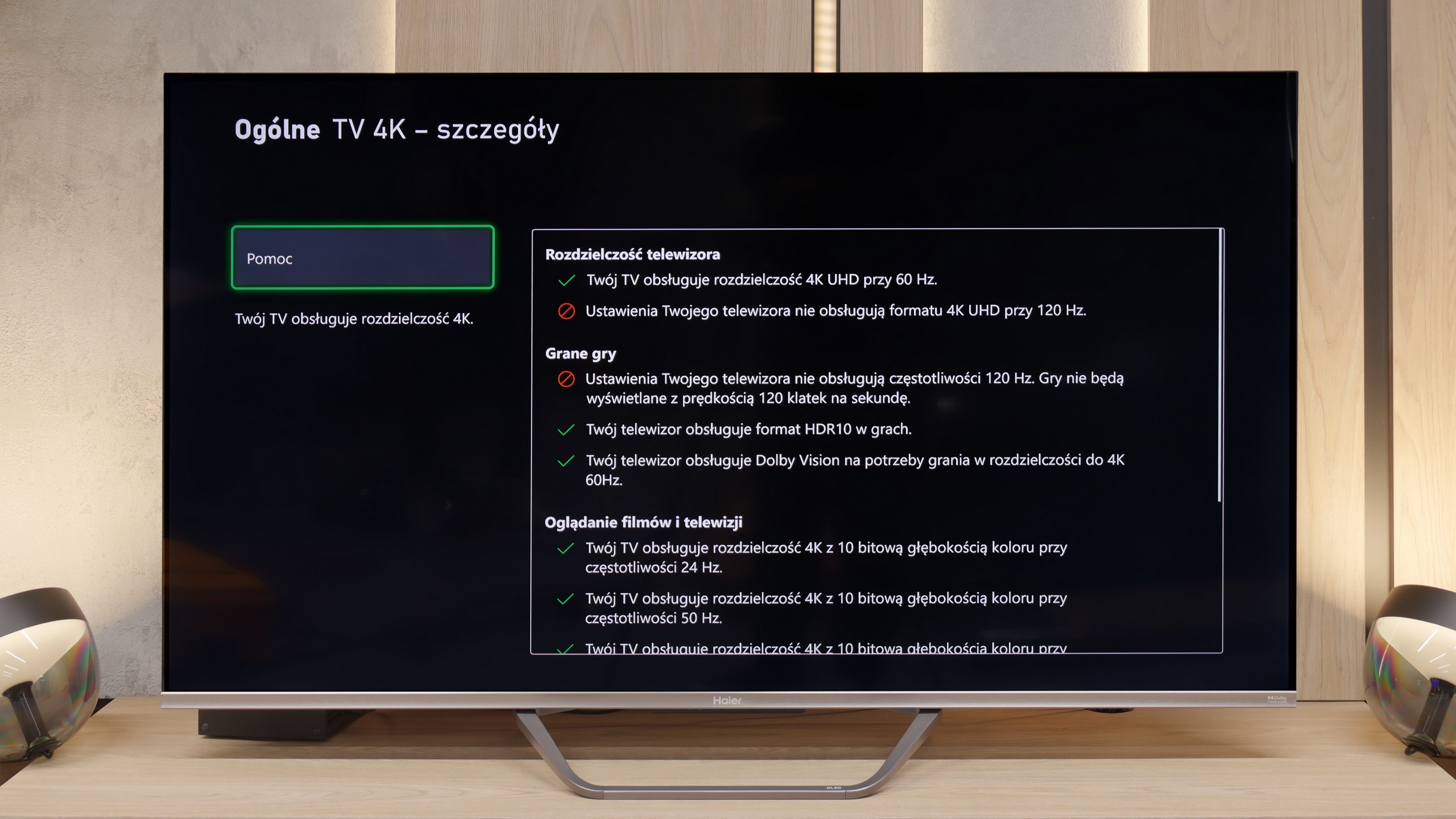




The tested television is equipped with four HDMI 2.1 ports. Interestingly, all of them have a bandwidth of 40 Gbps; however, during the testing process, we did not observe any negative effects associated with this situation. More importantly, Samsung Q70D supports all features stemming from the aforementioned standard. This news will surely delight all gamers, as it means that whether using a console or a PC, we can expect the highest possible comfort during gameplay. Given the standard absence of Dolby Vision HDR for this manufacturer, it is significant that the HGIG mode has been implemented correctly and there are no issues with setting up the calibration chessboard. We particularly note that Samsung is the only manufacturer to allow gaming with the smoothness enhancer switched on, without significant degradation. This means that titles running at 30 fps will be perceived like those with native 60 frames per second.
Samsung, as one of the first manufacturers, introduced the Game Bar to its televisions, which has since been consistently refined. It contains all the necessary information regarding gameplay parameters that we can change "on the fly".
In summary: Samsung Q70D will perform excellently both with consoles and with computers. All functions worked brilliantly, and there were no issues with them. The ability to enable the smoothness enhancer without significant increases in input lag is a true gamechanger.
Entering the realm of gaming, the Haier Q80FUX proves to be quite a good companion for the "casual gamer." It is equipped with some highly sought-after features today such as VRR (variable refresh rate) and ALLM (automatic low latency mode). However, the biggest surprise is something else. Even though we don't have a 4K@120Hz panel here, the television can accept and display a 120Hz signal at a lower resolution (Full HD). This is a very useful feature, allowing you to consciously switch the console to a lower resolution mode in exchange for significantly higher fluidity, which is a perfectly acceptable compromise in the gaming world.
We won't particularly complain about the lack of additions like the "Game Bar," as it's just a nice extra. However, the most concerning issues arise when we enter the world of HDR in gaming. Due to the fact that the television continuously adapts the signal "in its own way," setting the brightness on the console according to the HGIG standard is almost impossible to accomplish according to the instructions. Worse still, in Dolby Vision mode for gaming, the input lag increases to around 50 ms, which is a high enough value that essentially makes this mode unusable. Generally speaking, we still wouldn't recommend gaming on this television in HDR mode, so these aren't that serious shortcomings. What’s most pleasing is the presence of 120Hz in Full HD, making the Q80FUX quite a cool television for the occasional gamer.
Input lag
10/10
9.4/10
SDR
HDR
Dolby Vision
Results of latency on the Samsung Q70D are at a high level, regardless of the signal or resolution. All gamers will certainly appreciate the manufacturer's efforts, which allow a game running in 4K 120 Hz with HDR to have only 7 ms of latency, which is practically unnoticeable even in online gaming. It's worth adding that lag with the motion smoother turned on roughly doubles, which still means very comfortable gaming in this case.
If there is one category in which the Haier Q80FUX absolutely shines and shows its claws, it is input lag. In this respect, the TV presents downright outstanding results. In 120Hz mode (achieved, let's remember, at a lower resolution), input lag drops below 10 ms, which is an excellent value, worthy of top gaming monitors. Only slightly worse, but still at a very good level, is the classic 60Hz mode – here, measurements consistently indicated around 12-14 ms. These are results that much more expensive, dedicated gaming constructions would not be ashamed of. The only, but significant, stumbling block is the Dolby Vision mode. As we established earlier, its activation raises input lag to an unacceptable level, so we definitely advise against using it during any interactive gameplay.
Compatibility with PC
8/10
6/10


After connecting the television to the computer and wishing to use it as a monitor, we can expect a low input lag of 13 ms, which is practically unnoticeable on the mouse-screen-eye line. Thanks to the correct implementation of chroma 4:4:4, the readability of fonts is at a high level, so you can confidently connect Samsung Q70D to your computer as a monitor and expect a comfortable experience with text.
The subpixel layout is BGR, which does not negatively affect the use of the television as a monitor. However, as operating systems are not adapted to this type of subpixel format, it may cause slightly less distinct contours. This is, however, something practically negligible, and only a handful of people may notice it.
We also checked how the Q80FUX performs when connected to a computer. Here again, we were pleasantly surprised – it handles this really well. The most important thing is that the fonts are very readable, so nothing blurs and you can work normally on it. Additionally, just like with consoles: we can set a lower resolution here to achieve a high refresh rate of 120Hz in return. What’s crucial is that in this mode, G-Sync started correctly and functioned well. This just confirms that this television is truly a successful and efficient piece of gear for gaming, also on a PC.
Viewing angles
2.9/10
3.3/10
Due to the VA panel, the performance of Samsung Q70D in terms of viewing angles is its Achilles' heel. Even a slight shift off-axis leads to a significant loss of contrast and a substantial degradation of colours.
Anyone planning screenings with a wide family group must be aware of the fundamental compromise that Haier has decided upon by implementing a VA panel in this model. This technology has indeed provided us with deep blacks and high contrast, but an inherent characteristic is also a noticeable narrowing of viewing angles. It’s enough to sit a bit further to the side of the couch to immediately notice how the colours start to lose saturation and the image fades. It’s simply a classic trade-off – we gain something (contrast) at the expense of something else (angles) – and the Q80FUX fits perfectly into this scheme.
Daytime performance
5.4/10
4.8/10

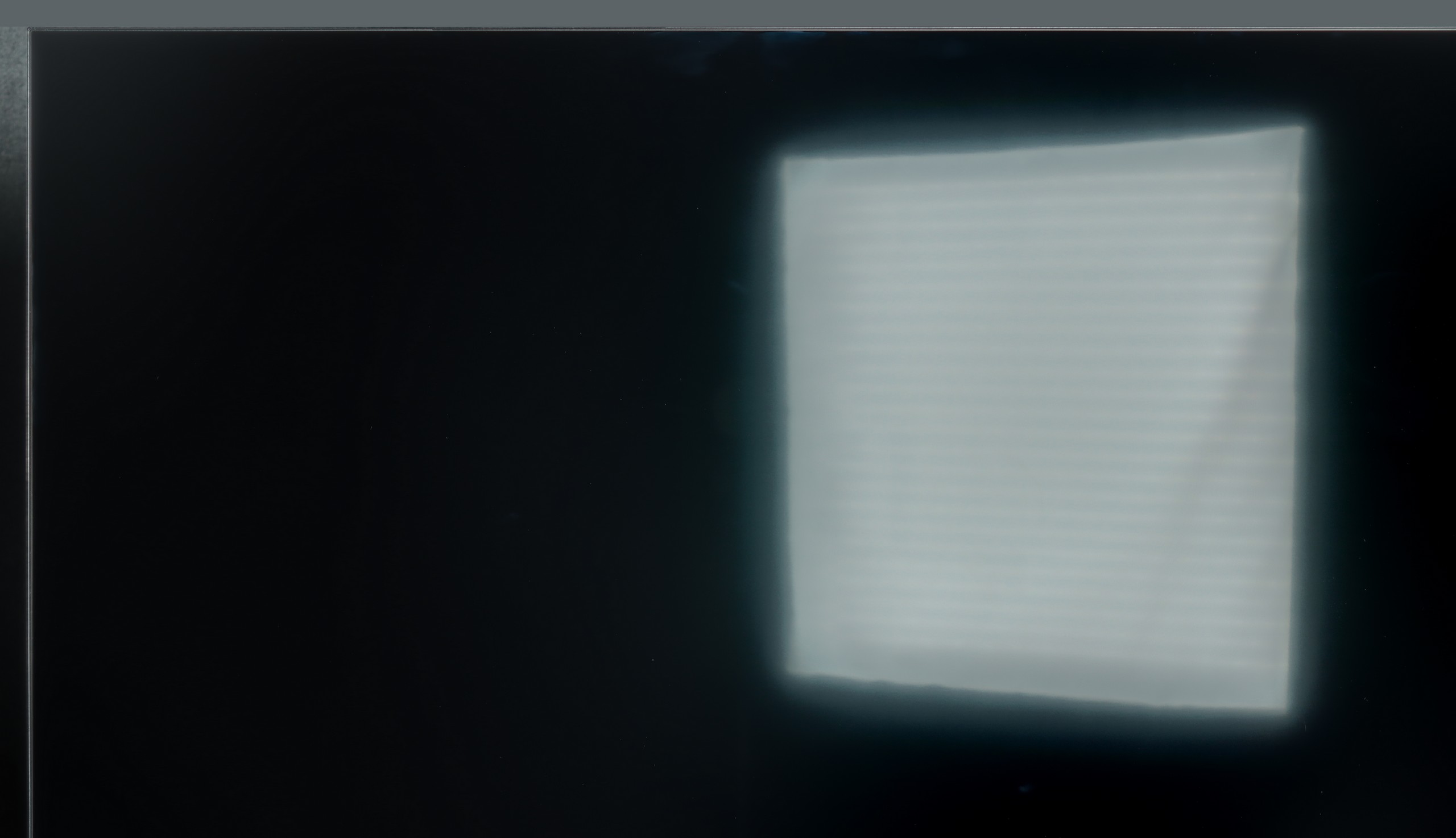


Panel brightness
Average luminance SDR
Haier Q80FUX: 317 cd/m2
Samsung QLED Q70D / Q74D / Q77D: 449 cd/m2
The satin finish of the panel in the Q70D allows for quite good performance in a well-lit room. It is worth noting that reflections do not spread beyond their source, and thus do not bleed onto the rest of the panel. We also commend the maximum brightness of the TV in SDR content, which is 450 nits, allowing for comfortable content consumption during the day.
The receiver's clash with the daily challenges posed by a bright lounge is quite decent with the Q80FUX, although it's certainly hard to talk about perfection here. The panel itself is equipped with a coating that effectively manages to suppress most reflections and glare from the surroundings. Equally important, even in more challenging lighting conditions, the screen can maintain pleasantly saturated colours. However, the weakness of this construction is revealed when backlight brightness comes into play. The previously mentioned, rather moderate maximum brightness (around 350 nits) means that in confrontation with intense natural light coming through the window, the screen often struggles to "break through." On a sunny day, the image might simply lack the necessary expressive strength.
Panel details
Subpixel Structure:

Panel uniformity and thermal imaging:


Samsung QLED Q70D / Q74D / Q77D
Haier Q80FUX
TV features
7.4/10
5.6/10
- HDMI inputs0 x HDMI 2.0, 4 x HDMI 2.1 40Gbps4 x HDMI 2.0, 0 x HDMI 2.1
- Other inputsRCA (Chinch)
- OutputsToslink (Optical audio), eARC (HDMI), ARC (HDMI)Toslink (Optical audio), eARC (HDMI), ARC (HDMI), Mini-Jack (Headphones)
- Network InterfacesWi-Fi 2.4GHz, Wi-Fi 5GHz, Ethernet (LAN) 100MbpsWi-Fi 2.4GHz, Wi-Fi 5GHz, Ethernet (LAN) 100Mbps
- TV receptionDVB-T, DVB-T2, DVB-S, DVB-S2, DVB-CDVB-T, DVB-T2, DVB-S, DVB-S2, DVB-C
Classic features:
- Recording to USB (terrestrial TV)
- Recording programming
- Picture in Picture (PiP)
- RF remote control (no need to aim at the screen)
- Backlit remote control
- Teletext
- Audio only mode
- Bluetooth headphones support
- Simultaneous Bluetooth headphones & TV audio
Smart features:
- AirPlay
- Screen mirroring (Windows Miracast)
- Voice search
- Voice search in native language
- Ability to connect a keyboard and mouse


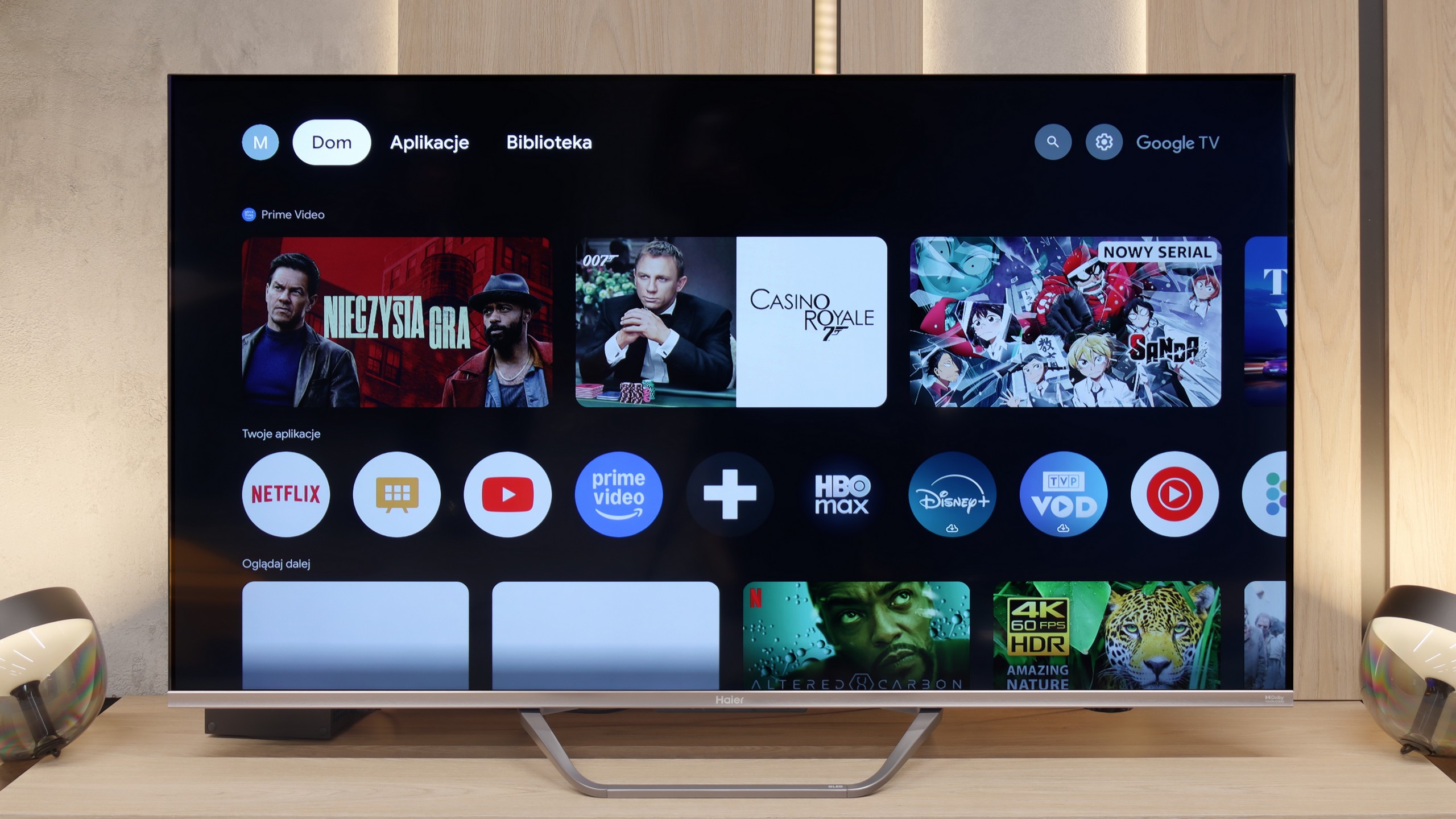
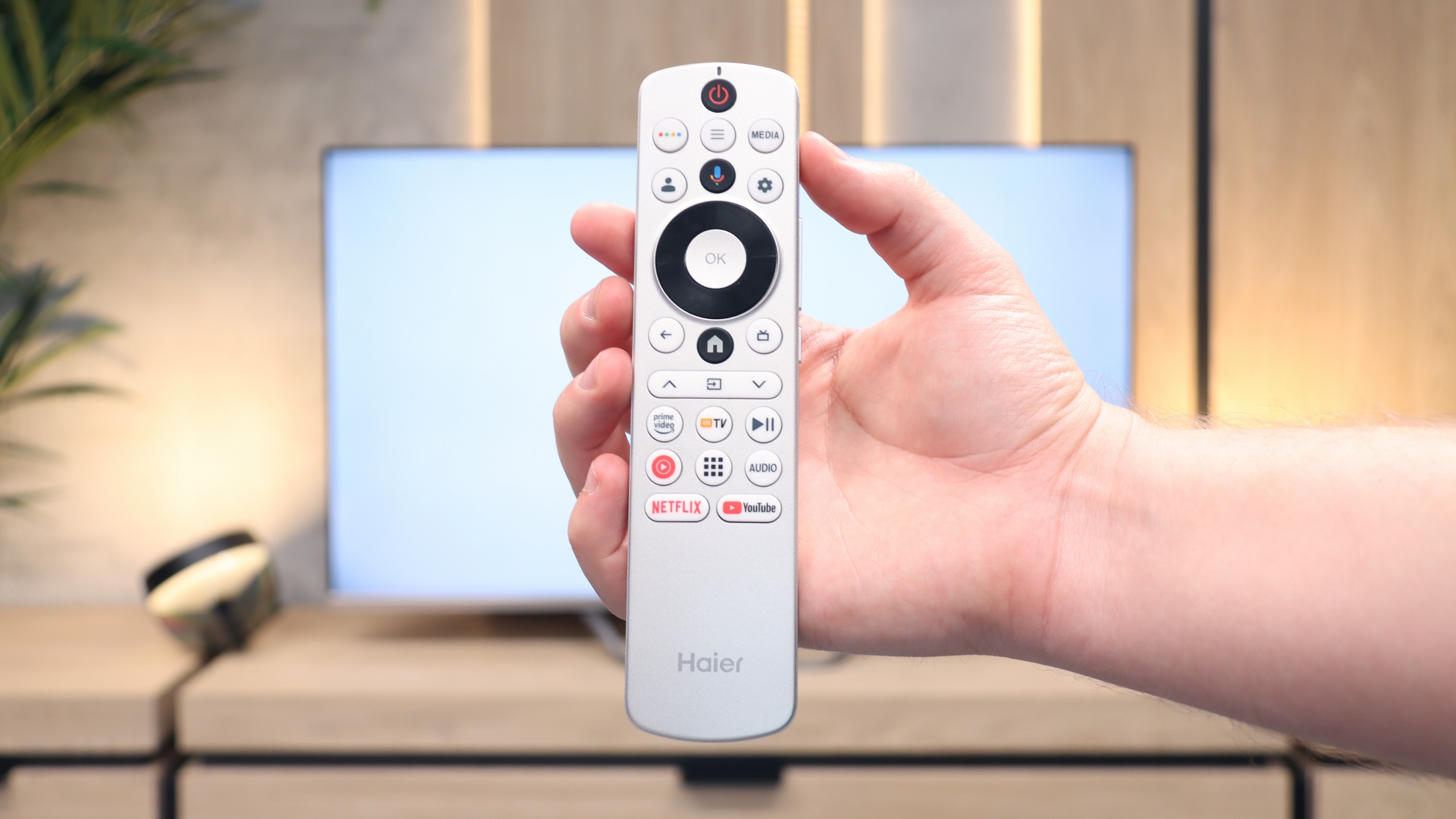

The operation of Samsung Q70D is managed by the proprietary Tizen system. This is fairly well-known software, as the manufacturer has been developing it in their TVs for quite a long time. Its main advantage is smooth operation and a lack of significant stutters, which we can confirm through conducted tests. The biggest downside, however, is its closed nature. Although the app store is quite extensive, we are still dependent on the grace or displeasure of the manufacturer. Therefore, we will not be able to install missing items, even from a USB drive. A perfect example of this is this year's discontinuation of support for the Tidal app. On the other hand, a benefit, especially for Apple device users, is the implementation of AirPlay functionality, which allows for easy screen mirroring from a device to the TV. Fortunately, Samsung also provided the option to connect a keyboard and mouse for much quicker navigation through the TV menu. It’s worth mentioning that the manufacturer has thankfully included a remote that connects via Bluetooth this year, which often wasn't the case in the past. The Tizen system has one more advantage. It integrates very well with external devices, such as the NC+ decoder or soundbars. The connection process is very quick and does not require special skills.
In summary: The Tizen system is very efficiently functioning software, which is certainly a strong advantage of the TV. While more advanced users may complain about the lack of something like KODI, the rest will be satisfied.
SmartTV on Haier Q80FUX: GoogleTV
First up, let's take a look at the smart layer, which in the Q80FUX is managed by the Google TV system. This is theoretically a huge advantage, providing access to an incredible library of apps, making it easy to cast from mobile devices, and offering convenient voice search. Unfortunately, like in other models from this brand that we've tested, the implementation of this platform leaves much to be desired. It’s not even about drastic freezes or delays in navigation, but rather a festival of minor bugs, shortcomings, and terrible translations in the menu. Because of this, it's hard to consider "Google TV" in Haier's version on par with what we know from Sony or TCL receivers, even though the same, proudly sounding name is on the box.
Classic Features
Moving on to the classic, functional features of the TV, the device's performance does not improve at all. The only thing worth praising is the presence of Bluetooth connectivity and an unusual but handy relic of the past in the form of an analogue headphone jack output. Apart from that, it's hard to find anything that would excite us. Due to the problematic software, the receiver (like its predecessors in our tests) was unable to find any terrestrial TV channels, even though other TVs connected to the same installation had no such issues. The remote control is also strange – its design may appeal to some, but due to the lack of a numeric keypad and the absurd placement of some buttons on the side edge, it definitely cannot be called senior-friendly.
Playing files from USB
9.1/10
9.6/10
Supported photo formats:
Maximum photo resolution:

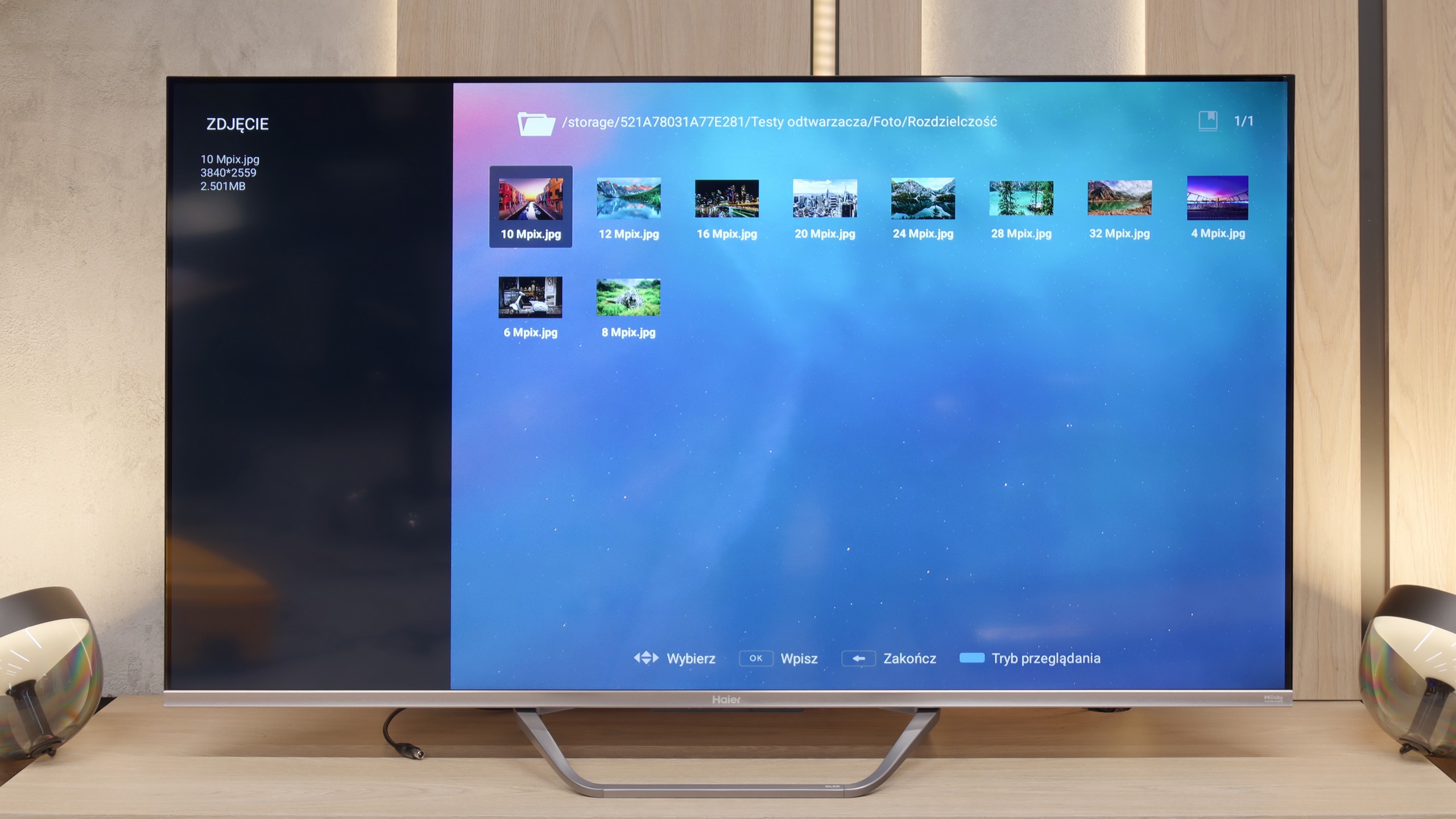
The built-in player Samsung Q70D is a significant advantage. It handled nearly all video and audio files prepared for the testing process exceptionally well. The only exceptions in this regard are of course the Dolby Vision format (which is not surprising) and less popular codecs. Additionally, it is worth noting the support for Polish characters and the ability to change font colours as a positive aspect. However, it struggles more with photo formats, as it only supports JPEG among the popular ones. There's definitely a lack of formats like PNG or Apple's HEIC here.
We must admit that after a series of setbacks we faced in assessing the overall implementation of the Google TV system, we approached the media player test with a fair bit of caution. Meanwhile, in this one specific aspect, the Q80FUX served us a real surprise. The built-in app for handling files from USB drives works simply brilliantly. This software component seems to be completely immune to the issues plaguing the rest of the system, opening practically all the most important and popular video file formats that we threw at it.
Apps
8.7/10
9.6/10














































Sound
6.3/10
5.5/10
- Maximum volume-84dB
- Dolby Digital Plus 7.1
- Dolby True HD 7.1
- Dolby Atmos in Dolby Digital Plus (JOC)
- Dolby Atmos in Dolby True HD
- DTS:X in DTS-HD MA
- DTS-HD Master Audio
The built-in audio system Samsung Q70D, due to its slim design, is not among the most outstanding. Overall, it's fairly balanced, although we wouldn't recommend cranking up the volume to levels higher than 2/4 of the scale. However, if we have a home theatre system, there is a range of codecs available, and we can enjoy the presence of the most important ones, namely DTS-HD Master Audio and Dolby Atmos.
When it comes to "acoustic experiences," the Haier Q80FUX seems to adhere to the principle that sound is simply meant to be. And it is – that's about all that can be said for it. The built-in speakers produce sound in an extremely flat manner, lacking character, and most importantly, they are missing any clear bass foundation. A slight consolation is the fact that the television supports the Dolby Atmos format. However, let's be honest: to realistically take advantage of the benefits of this codec and hear the promised space, passive decoding capability is simply not enough. Connecting an external home theatre system or at least a decent soundbar is not just a recommendation in this case; it's an absolute necessity.
Sound Quality Test
No sound test video
Acoustic Measurements
No acoustic data
84dBC (Max)
75dBC
